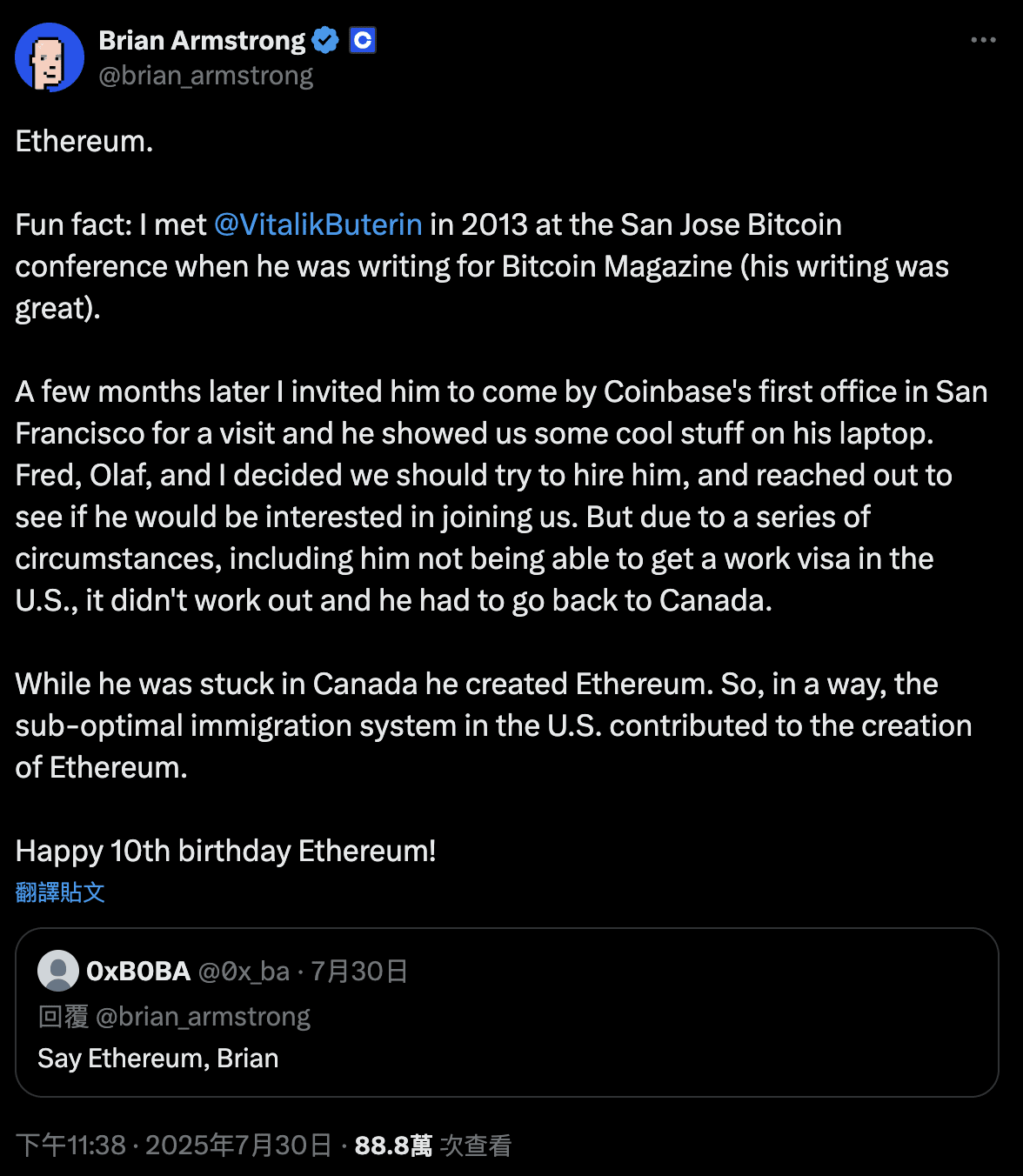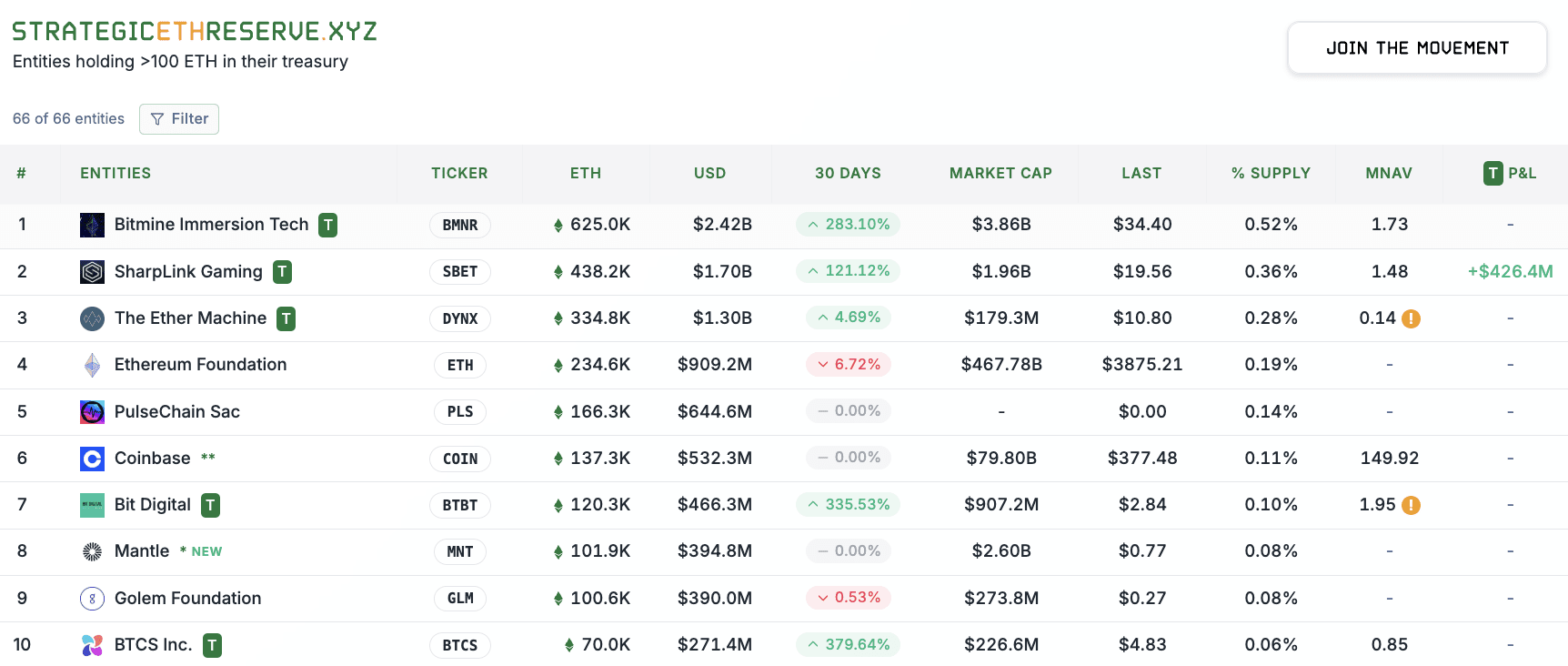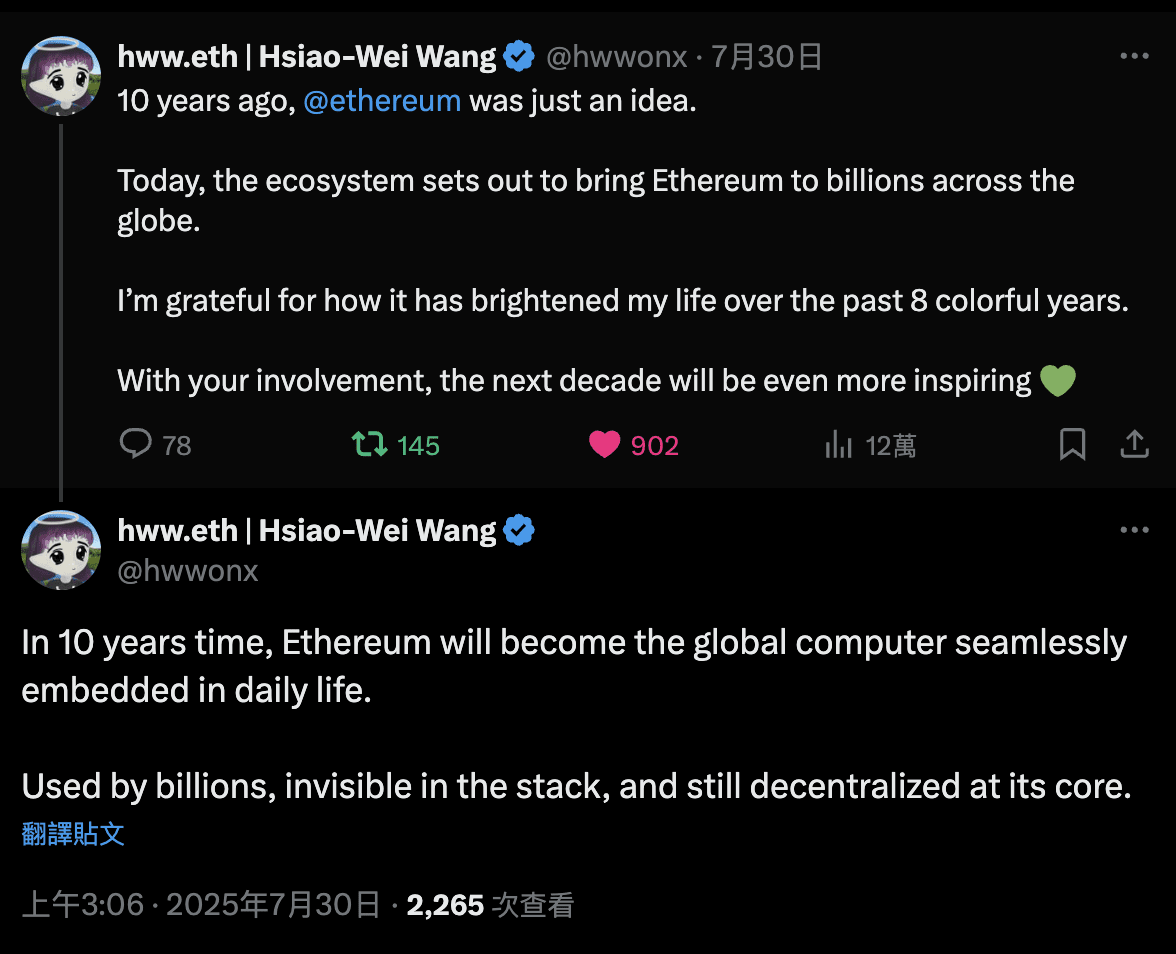Immigration policy inadvertently fostered a blockchain giant, leading the U.S. to miss out on a trillion-dollar ecosystem.
On July 30, ten years ago, Ethereum officially launched, but this blockchain empire, now worth hundreds of billions of dollars, was born out of a visa denial case. Coinbase CEO Brian Armstrong revealed that in 2013, he wanted to hire the then 19-year-old Vitalik Buterin (later known as V God), but was forced to abandon the idea due to U.S. visa issues, leading V God to return to Canada and create Ethereum.
 Source: X/@brian_armstrong. Coinbase CEO Brian Armstrong shares anecdotes from the early days with Vitalik Buterin on the occasion of Ethereum's tenth anniversary.
Source: X/@brian_armstrong. Coinbase CEO Brian Armstrong shares anecdotes from the early days with Vitalik Buterin on the occasion of Ethereum's tenth anniversary.
This 'what if' story is not only an interesting episode in the history of technology but also highlights the profound impact of policy decisions on innovation. At that time, the U.S. immigration system failed to recognize this genius in an emerging industry; the H-1B visa required a bachelor's degree, while the 'extraordinary ability' standard of the O-1 visa was too high for an almost non-existent industry. Vitalik dropped out of the University of Waterloo to specialize in blockchain technology, which was barely understood at the time.
After his visa was denied, Vitalik Buterin gained creative freedom in Canada, unbound by corporate direction, allowing him to fully dedicate himself to his revolutionary concept. In November 2013, he published the Ethereum white paper, proposing a programmable smart contract platform that transcends the limitations of Bitcoin. This pivotal moment changed the trajectory of digital history, establishing the Ethereum ecosystem in Toronto and Zug, Switzerland, rather than Silicon Valley.
A decade-long journey witnessing the immortal myth, from experiment to infrastructure.
Ethereum's ten-year journey has been filled with challenges and breakthroughs. The public pre-sale in 2014 raised over 31,000 Bitcoins, worth about $18.3 million, laying the groundwork for network development. After its official launch on July 30, 2015, Ethereum experienced the DAO hack, a controversial hard fork, network congestion due to the 2017 ICO boom, and the 'Merge' upgrade transitioning from proof-of-work to proof-of-stake.
Consensys CEO and Ethereum co-founder Joseph Lubin describes Ethereum as 'the definition of anti-fragility,' maintaining uninterrupted uptime over the past decade. Even after being declared 'dead' multiple times, Ethereum remains resilient, evolving from a smart contract platform to the foundation for innovations such as DeFi, NFTs, Layer 2 scaling, and zero-knowledge proofs.
This resilience has attracted the attention of traditional financial giants. Institutions like BlackRock, JPMorgan, and Visa have begun building services on Ethereum, recognizing its programmability and security. Companies' interest in Ether ($ETH) is also reflected in inventory strategies; according to data from Strategic ETH Reserve, SBitMine Immersion Technologies holds 625,000 Ether, and Sharplink holds 438,200 Ether as primary inventory assets, indicating that Ether is becoming the emerging inventory asset following Bitcoin.
 Source: Strategic ETH Reserve. Companies' interest in Ether is also reflected in inventory strategies, with more companies viewing Ether as a reserve asset.
Source: Strategic ETH Reserve. Companies' interest in Ether is also reflected in inventory strategies, with more companies viewing Ether as a reserve asset.
Corporate adoption accelerates, and Wall Street views Ether as the next strategic asset.
Ethereum's tenth anniversary coincides with a wave of corporate adoption. Since June, crypto-focused companies have purchased over 1% of the circulating supply of Ether, surpassing the procurement speed of Bitcoin-focused companies during the same period. A report from Standard Chartered Bank indicates that Ethereum-focused companies may hold up to 10% of the total supply in the long term, primarily driven by regulatory arbitrage opportunities and the ability to earn programmable yields through staking and DeFi.
Bitget CEO Gracy Chen stated, 'Given the high likelihood of world assets being tokenized on the blockchain, Ethereum has a competitive advantage in capturing a significant market share.' She added, 'Wall Street firms and the broader traditional finance sector are embracing the idea of Ethereum as a reserve asset.'
GameSquare CEO Justin Kenna's reason for investing in Ether is 'believing it is the most trustworthy long-term digital asset, aligned with the development direction of the internet.' He believes Ethereum is evolving into 'the financial and cultural pillar of the internet, powering global payments, asset management, entertainment IP, gaming economies, and digital identities.'
Vision for 2035: An invisible global computer reshaping the digital world.
Looking forward to the next decade, Ethereum Foundation co-executive director Wang Xiaowei predicts that Ethereum will become a 'global computer seamlessly embedded in daily life, used by billions, invisible in the technology stack, yet fundamentally decentralized.' She emphasizes that achieving this vision requires a balance between innovation speed and network stability, scalability and throughput, inclusiveness and efficiency, as well as privacy features and low-cost transactions.
 Source: X/@hwwonx. Ethereum Foundation co-executive director Wang Xiaowei predicts that Ethereum will become a global computer seamlessly embedded in daily life.
Source: X/@hwwonx. Ethereum Foundation co-executive director Wang Xiaowei predicts that Ethereum will become a global computer seamlessly embedded in daily life.
Consensys Chief Economist Mallesh Pai predicts, 'In the next 5 to 10 years, Ethereum will evolve from the world's leading smart contract platform to the foundational layer of the future global economy.'
RedStone co-founder Marcin Kaźmierczak believes that Ethereum will evolve into 'a foundational layer for institutional finance and real-world asset tokenization.'
Sam McIngvale, product lead at OP Labs for Optimism, predicts, 'In the next 10 years, every large enterprise will be on-chain, with most vertically integrated into their own infrastructure built on top of Ethereum.'
Coinbase developer head Nemil Dalal is optimistic about 'new applications such as AI agents trading on our behalf, richer on-chain social communities, and gaming.'
From an idea in 2013 to a multi-billion dollar ecosystem today, Ethereum's story exemplifies the unpredictability of innovation. As early supporters have said, Ethereum's most incredible feature is 'it refuses to die,' surviving forks, failures, regulatory attacks, and civil wars to become the cornerstone of future finance.
'The Evolution of Ethereum Over Ten Years: The Immortal Myth Witnessed by Believers, What Will 2035 Look Like?' This article was first published in 'Crypto City.'

